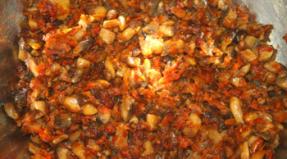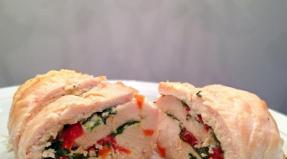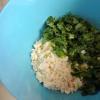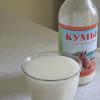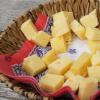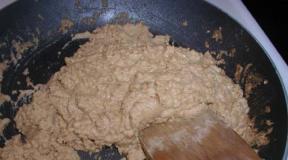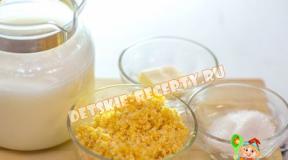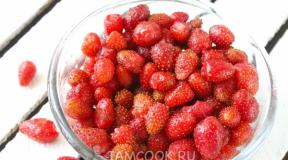How to bake sourdough bread without yeast. Sourdough bread
Why did our Slavic ancestors attach great importance to bread? If you think - because it was the most easily obtained food product that saved you from hunger, then you are mistaken. Bread was given special importance because it was a very healthy product, with a wonderful taste, which everyone loved. It was REAL BREAD giving satiety, strength and health. It was so because our forefathers prepared it correctly. Only the right bread can really satisfy your hunger and give you health.
The REAL BREAD of the Slavs has always been sour. And that's what the sourdough made him do. What happens during fermentation, if our ancestors could not imagine bread without it?
Firstly, there are protective substances in cereals (a kind of preservatives), which allow the grain to be stored for a long time and greatly prevent its digestion. For example: phytic acid does not allow the body to absorb the necessary minerals and trace elements (such as calcium, magnesium, copper, iron, zinc); other substances block the work of enzymes, which causes the body to additionally spend its internal resources; tannins, gluten and related proteins, and indigestible complex sugars can cause allergies, indigestion, and even mental disturbances. The properties of these substances do not weaken when grinding grain into flour. The action of protective substances is terminated only when the grain gets into conditions suitable for germination or during prolonged fermentation of the dough with the help of sourdough.
Secondly, during acid fermentation, complex substances are broken down into simpler ones (which are easier to digest and assimilate by the body), and in addition, new nutrients necessary for the body are formed.
For these two reasons, sourdough bread is very satisfying. In these reasons lies the benefits of sourdough bread.
There is another very important point: the cooked bread must be well baked so that fermentation stops in it and the bread does not turn sour.
By the way, not only black (rye), but also white bread can be sour, as long as the flour for it is real - whole grain flour.
Whether our ancestors knew or not, the lactic acid bacteria found in sourdough neutralize the grain's internal defenses and make the grain's nutrients more accessible. But they always let the sourdough work on the dough (to maximize the benefit of the bread), and they got a refined bread that they appreciated.
What happened today? This knowledge exists, but civilized society ignores it, producing industrial unleavened bread.
But you yourself can bake the REAL BREAD - the bread of the ancestors - the bread that gives strength! Only such bread is worthy of you!
1. Cooking the sourdough
200 gr. water
200 gr flour
100 gr. bran
2 spoons of honey
5 gr. raisins
Mix everything thoroughly and put in a warm place until fermentation begins. As soon as fermentation begins, mix thoroughly and leave for 4 hours. Fermentation can begin on the first or second day ... It is better to keep the sourdough for 3 days ...
2. Prepare dough for dough
1000 gr. water
Salt to taste for the dough
Sugar or honey 2 tablespoons
100 gr. bran
200 gr. flour
200 gr. sourdough (leave the rest of the sourdough in the refrigerator for the next time)
You need to keep the dough for 8 hours ...
3. Cooking the dough
For more than a year now, we have not bought bread, but baked it at home in a conventional oven. Kneading and baking bread takes us very little time and it has already become a habit. The most important and painstaking is the preparation of sourdough. And everyone has their own recipe for its creation. We bring to your attention a few recipes for making sourdough at home.

RYE STEADER
Day 1: Mix 100 g of whole grain rye flour with water until the consistency of thick sour cream, cover with a napkin and put in a warm place without drafts.Day 2: Bubbles should appear on the sourdough. If there are few of them, no big deal. Now the starter needs to be fed. We add 100 g of flour and add water to get the consistency of thick sour cream again. Leave it in a warm place again.
Day 3: The starter has grown in size and has a foamy texture. Again, add 100 g of flour and water and leave in a warm place.
A day later, the sourdough is ready for use.
RAISIN STARTER
Day 1: Mash a handful of raisins, mix with ½ cup water and ½ cup rye flour, add 1 tsp. sugar or honey, put everything in a jar, cover with a cloth or a leaky lid and put in a warm place.Day 2: strain the starter, add 4 tbsp. flour and warm water until the density of sour cream and again put in a warm place.
Day 3: The sourdough is ready. Divide it in half, add 4 tablespoons to one part. flour, water (until the density of sour cream) and refrigerate. Use the other part for baking bread.
GRAIN STEADER
Day 1: Soak 1 cup of grain (wheat for wheat bread or rye for "black bread") for sprouting, wrap the dishes with a towel, put in a warm place.Day 2: if the grain has not sprouted all, then rinse it, leave it in a warm place until the evening. Grind the germinated grain, mix with 2 tbsp. rye flour, 1 tsp sugar or honey, put in a warm place under a napkin or towel.
Day 3: The sourdough can be divided, part left in the refrigerator, and the other part used to make dough.
KEFIR STARTER
We take curdled milk or old kefir (preferably homemade), keep it for several (2-3) days until bubbling and separation of water, and the smell characteristic of sour kefir.Add rye flour to the consistency of liquid sour cream, mix well and cover with gauze, leave for a day. Fermentation will begin to actively occur in the sourdough, it will begin to peroxide.
A day later, add rye flour to the consistency of a dough for pancakes of medium density, mix thoroughly. Cover again and do not touch until ripe.
Several hours pass and the starter begins to actively bubble and rise, if the container was small, it can crawl out. In this active state, it can be added to the dough.
HOP STARTER
Day 1: in the evening, pour 1 tbsp in a thermos. dry hop cones 1 cup boiling water, close the thermos and leave until the morning.Day 2: strain the resulting infusion into a two-liter jar, add 1 tbsp. sugar or honey, stir well, add rye flour to the consistency of thick sour cream. Put in a warm place, covering the jar with a cloth.
Day 3: The starter will become liquid and frothy, the smell is still unpleasant. Add flour until thick sour cream, cover and put in a warm place.
Day 4: mix the starter, add warm water (1/2 or 1/3 of the starter volume), mix and add the flour until the sour cream thickens.
Day 5: add water and flour again.
Day 6: use part of the starter to make dough, put the remaining starter in the refrigerator, adding water and flour until sour cream is thick.

We sometimes store sourdough in the refrigerator for up to a week, until we eat all the bread. Then we add fresh flour and put the fridge back on. So the sourdough can live for a very long time.
If the starter is acidic, add flour and leave to cool. The next day it will outlive and can be used. Sour sourdough will make sour bread, but some people even like it.
It is very important that the flour is of the same grade, we take organic coarse grinding and never store-bought. The bacteria have to get used to the new type of flour and sometimes it takes longer. We add new flour in several passes. 
For spaghetti and pizza, durum flour is used, for soft bread. Sometimes it takes time to find the right variety based on taste.
If you're having trouble making a starter, or if you want to save time, look for ready-made starter in clubs or in thematic groups on social networks.
Do the leaven in silence or in a positive way. We mostly leave the fermentation process overnight or go for a walk so as not to distract the bread from work)
Bon Appetit!
Based on materials
When I became interested in how to bake bread without yeast, using self-grown sourdough, I began to read what they write about it on the Internet, and for a long time I could not decide to try it, because I had read a lot of positive-tuning things like "of course you can try to bake bread according to my recipe, but it’s unlikely that you will succeed right away, since it’s very difficult and not for everyone” or “a lot of products went into the trash before I got it” or “I baked my one hundred and hundredth bread and only now it began to remotely resemble something edible" or "take a sourdough 75.21% moisture freshened at dawn after the full moon". Of course, I'm exaggerating, but I think many will understand me)))
Having met even in one out of a dozen recipes, such moods frighten most beginners and people either generally think that baking bread is something incomprehensible and do not dare, or gather their courage for a long time, like me. And then I thought that humanity began to produce industrial yeast quite recently, and before that bread was baked on sourdough, and it’s hard to imagine that in some village, a simple woman with a bunch of children and a household, sat and calculated the percentage of sourdough moisture or something something like that. I realized that the process of baking bread is a natural and generally simple procedure that is available to any housewife.
Armed with this understanding, I overcame my fear, began to boldly try recipes that contained less cleverness and intimidation, the bread immediately began to turn out delicious (yes, sometimes a little better, sometimes a little worse, but always tasty) and gradually I formed some of the simplest and most popular recipes, which I always get well if the main conditions are met: live and healthy sourdough, sufficient heat for rising, aged at the right time, good kneading and the desire to feed your loved ones with tasty and healthy bread.
At some stage, I got tired of telling my girlfriends and other people every time how and what to do, and I compiled a file in which I collected and systematized everything that I understood for myself about baking bread. Here I share this information with you, I hope it will be useful to someone.
LEAVEN
Sourdough is a substitute for industrial yeast. It needs to be grown, and then it can be stored for years, becoming stronger, it will only be necessary to feed it in time.
How to grow rye sourdough starter
It will take several days to grow the sourdough:
| 1 day | Mix 50 g of rye flour + 50 g of slightly warm water in a liter jar, cover with a lid or film (do not close tightly) and put in a locker for a day. |
| 2 day | After standing for a day, the leaven should ferment, increase in volume. Add 50 g of rye flour and 50 g of slightly warm water, mix, cover and return to the locker for a day. |
| 3 day | The sourdough continues to ferment. We do the same as on the second day: 50 grams of flour + 50 grams of water |
| Day 4 | Everything is the same as the third day. |
| Day 5 | The starter is ready. It should be alive, bubbling, voluminous. In total, it turned out about 400 grams of sourdough. From this amount, you need to select 100 grams, put it in a jar, tightly close the lid and refrigerate. This will be the actual starter, from which each of your bread will then be fermented. The rest of the starter can already be used (see the tip in recipe number 1). |
How to handle starter culture?
The sourdough starter sits quietly in the refrigerator. When baking bread, take as much from the jar as the recipe calls for. And immediately add flour and water to the jar (I add 25-50 grams of flour and 25-50 grams of water (25 or 50 depends on how much sourdough I took for bread)), mix and put it back in the refrigerator - so you fed the sourdough. If you bake bread regularly, then you won’t have to do anything else with sourdough. If you rarely bake, then the sourdough should be fed once a week in any case. After the starter has been fed, after a while it will bubble up and rise strongly, then calm down. It is necessary that the size of the jar be such that there will be room to rise.
In any actions with sourdough, maximum accuracy is important: clean dishes, hands, towels. It is necessary to ensure that, apart from flour and water, nothing gets into the sourdough.
It should look normal, in the active period - with large bubbles, in a calm one - with small ones. It should not be that flour exfoliated separately, water separately. Make sure there is no mold! If the starter is very stratified or moldy, throw it away and make a new one. But if the starter is kept in order and fed on time, such troubles should not arise.
WHEAT-RYE BREAD RECIPES
Comments on all recipes
- It is necessary to bake bread only in a good mood and with good thoughts!
- Flour is different, so the amount of flour and water indicated in the recipes can vary according to the situation. How? - you need to feel it, it comes with experience, for a start you can do it strictly according to the recipe, and then analyze it and gradually it becomes clear whether changes are needed or not.
- In all recipes, you need to take a little warm water, just above room temperature, excessively warm or hot water can destroy the sourdough.
- Dough is the pre-fermentation of part of the flour. The dough is already the actual dough itself, which will be baked.
- If the dough has stood for as long as it should, but for some reason you cannot immediately knead the dough, it's not scary - just put the dough in the refrigerator, knead the dough later.
- If according to the recipe it turns out that the dough itself needs a little less ready-made dough than it turned out, then the rest of the dough can simply be put into a jar in which the sourdough is stored.
- The dough must be well kneaded. Knead with your hands for at least 15-20 minutes. Since in all the above recipes the dough is sticky and not cool at all, you need to knead in a bowl, and not on the table.
- The dough, kneaded and laid out in molds, should rise twice. The rise time of the dough depends on the strength of the leaven and the temperature in the room. In the cold season, in order to rise better, it is better to put it either near the battery or on the table near the stove when something is being cooked.
- All the recipes below are designed for baking in molds. The most convenient form is a brick.
- If the bread has fallen off during baking, then the dough has stood or was too liquid, get used to it over time and this will not happen.
- If the baked dough turned out to be too porous, most likely the dough was too thin or poorly kneaded.
- Supplement options: coriander or cumin (which contribute to better digestion of bread, they should be added a little, 1-2 teaspoons), pumpkin or sunflower seeds, flax seeds, sesame seeds, poppy seeds, raisins, bran (visivki), chopped nuts, oatmeal . Add all additives at the end of the dough batch.
- Before putting the bread in the oven, grease it with water with a baking brush and immediately, until the water has dried, sprinkle with sprinkles (cumin, sesame seeds, poppy seeds).
- Put the bread in the oven carefully, without knocking, so as not to fall off. The oven must be preheated well in advance, bake at 200 0 minutes 40-50. But ovens are different, so you need to adapt to your own, this is important! Ready bread is ruddy, if you check with a splinter - it should be dry.
- Ready bread must be immediately removed from the mold, otherwise it will soak. Let the bread cool before cutting. If you start cutting hot, the dough will drag behind the knife and it will seem that the bread is damp. In general, rye bread tastes better when it has stood.
From the specified amount, 1 large brick is obtained, weighing 700-750 grams.
| Opara | Rye flour - 150 gr Water - 150 gr |
|
| Dough | Opara - 300 gr White flour - 200 gr Rye flour - 130 gr Salt - 10 gr Vegetable oil - 1 tablespoon Honey (or sugar) - 1 tablespoon Water - 200-230 gr |
Advice:
When the sourdough was just made, after the right amount was selected for storage in the refrigerator, 300 grams remained. Here they can be used in this recipe as a dough (i.e., take this sourdough and start making bread already from the “Dough” stage). True, the sourdough is not yet very mature, so for the first time you need to either add yeast, or be prepared in advance for the fact that the bread will rise for a long time or it may not turn out very well. It's not scary. When the sourdough is ripe, it will work well.
Recipe variant number 1 - with rye malt
| Opara | Rye flour - 150 gr Water - 150 gr Sourdough starter - 2 tablespoons |
Mix everything in a bowl, cover with a towel and leave at room temperature for 16 hours. |
| Malt | Rye malt - 25 gr Water - 50 gr |
|
| Dough | Opara - 300 gr Steamed malt (see above) White flour - 200 gr Rye flour - 105 gr Salt - 10 gr Vegetable oil - 1 tablespoon Honey (or sugar) - 1 tablespoon Water - 150-180 gr |
Mix everything, knead thoroughly. At the end of the batch, add a handful of additives (seeds, etc.) Grease the form with oil and put the dough into it. Flatten with a wet hand as the dough will stick. Cover with a towel and put in a warm place to approach, for 2-3 hours (until it rises 2 times). When it comes up - sprinkle with what you want, and bake. |
Recipe number 2
Compared to the first recipe, this bread is more rye (rye flour is 2 times more than wheat flour). From the given amount, 2
large bricks, each weighing 850-900 grams.
| Opara | Rye flour - 300 gr Water - 500 ml Sourdough starter - 80 gr |
|
| Dough | Opara - 800 gr White flour - 400 gr Rye flour - 300 gr Salt - 1 tablespoon with top Vegetable oil - 1 tablespoon Honey (or sugar) - 1 tablespoon Water - 300-320 gr |
Grease the form with oil and put the dough into it. Flatten with a wet hand as the dough will stick. Cover with a towel and put in a warm place to approach, for 2-3 hours (until it rises 2 times). When it comes up - sprinkle with what you want, and bake. |
Recipe variant No. 2 - with rye malt
It turns out delicious dark bread like "Borodinsky"
| Opara | Rye flour - 300 gr Water - 500 ml Sourdough starter - 80 gr |
Mix everything in a bowl, cover with a towel and leave at room temperature for 10-12 hours. |
| Malt | Rye malt - 50 gr Water - 100 gr |
30 minutes before the start of kneading the dough, boil water, pour malt with this boiling water and let it brew for 30 minutes |
| Dough | Opara - 800 gr Steamed malt (see above) White flour - 400 gr Rye flour - 250 gr Salt - 1 tablespoon with top Vegetable oil - 1 tablespoon Honey (or sugar) - 1 tablespoon Water - 200-220 gr |
Mix everything, knead thoroughly. At the end of the batch, add 2 handfuls of additives (seeds, etc.) Grease the form with oil and put the dough into it. Flatten with a wet hand as the dough will stick. Cover with a towel and put in a warm place to approach, for 2-3 hours (until it rises 2 times). When it comes up - sprinkle with what you want, and bake. |
Recipe number 3
Unlike the first two recipes, this bread has more wheat flour than rye flour. From the specified amount, 1 large brick is obtained, weighing 800-850 grams.
| Opara | Sourdough starter - 2 tablespoons White flour - 2 cups Water - 2 glasses |
|
| Dough | Whole dough (see above) White flour - 1-1.5 cups Rye flour - 1 cup Salt - 2 teaspoons Honey (or sugar) - 2 teaspoons Vegetable oil - 1 tablespoon |
Mix everything, knead thoroughly. At the end of the batch, add 1 handful of additives (seeds, etc.) Grease the form with oil and put the dough into it. Flatten with a wet hand as the dough will stick. When it comes up - sprinkle with what you want, and bake. |
Recipe number 4
Pure white bread, although the sourdough is rye, but it will be lost there, and it will be white. From the specified amount, 1 large brick is obtained, weighing 800-850 grams.
| Opara | Sourdough starter - 2 tablespoons White flour - 2 cups Water - 2 glasses |
Mix everything in a bowl, cover with a towel and leave at room temperature for 12-14 hours. |
| Dough | Whole dough (see above) White flour - 2-2.5 cups Salt - 2 teaspoons Honey (or sugar) - 2 teaspoons Vegetable oil - 1 tablespoon |
Mix everything, knead thoroughly. Grease the form with oil and put the dough into it. Flatten with a wet hand as the dough will stick. Cover with a towel and put in a warm place to approach, for 2-4 hours (until it rises 2 times). When it comes up - sprinkle with what you want, and bake. |
A well-composed diet is dominated by cereals and other grains, including bread, which are a source of valuable nutrients. In our area, the traditional and popular source of fiber, protein, starch, B vitamins and trace elements is bread.
What is sourdough, and where does the sour taste come from?
We can say that our health largely depends on the quality of bread. Meanwhile, more and more baked goods are coming to the market with various additives, improvers and fillers. These pastries are not only unpalatable, too airy or flavored, but sometimes contain dangerous ingredients. the person then becomes apparent.
At the same time, home production, the use of starter cultures will allow us to bake healthy pastries, in the quality and composition of which we can be 100% sure.
Sourdough for bread at home consists of beneficial and friendly bacteria, lactic acid, from which bread takes useful substances after fermentation. Natural fermentation caused by lactic acid bacteria eliminates carcinogenic compounds and stimulates the immune system. In the light of modern nutritional knowledge, homemade bread sourdough, which is based on wild yeast, can become part of our daily diet.
Sourdough for bread is a means for raising and acidifying the dough. It is a community of various tiny microorganisms that depend on each other and protect each other. Such communities are present in our midst often and in large numbers. In kefir, sauerkraut, etc., they contain various bacteria and yeast.
What is sourdough bread made of?
Its most important components are:
- bacteria responsible for the production of lactic acid;
- other beneficial bacteria that live in symbiosis with them;
- wild yeast, which works like industrial yeast, produces carbon dioxide in the dough, which makes the dough rise.
Commercially made sourdough yeast bread has a somewhat distinct flavor. Although sometimes they try to fake this “sourness” by adding ordinary vinegar to bread made with industrial yeast.
What are the starter cultures?
Starter cultures can differ significantly from each other. Cultures of microorganisms, depending on the type of flour and grain, the region in which they are grown will be different. The secret lies in the presence of microorganisms that are located under the shell of the grain and in the air. You cannot compare a sourdough starter grown in one part of the country with the same product from the same recipe but from products grown in the opposite part of the country. The differences will be significant. One thing is for sure: each sourdough for rye bread or wheat, and maybe for corn is a unique product, has its own mysterious properties, and every culture we have bred deserves to be developed and cultivated.
So, the main types of this product:
- hop sourdough for bread,
- rye sourdough for bread without yeast,
- wheat sourdough for bread
- sourdough for bread without yeast eternal,
- sourdough for bread on kefir,
- monastery sourdough for bread,
- and many other types.
How to make sourdough for bread and why you should not be afraid of it?
Why is it worth adding sourdough to rye flour bread? If someone has already tried to bake 100% rye bread with yeast, he was convinced that this, unfortunately, is very difficult. Even if rye flour is only part of the recipe and used in a mixture with wheat, using it for baking is a difficult task. Beginning bakers are better off working with wheat flour products. Wheat flour has a lot of protein responsible for gluten, which holds the whole structure of the dough. Thus, it is easy to form a loaf from wheat flour that holds its shape quietly, while products made from rye flour are best always baked in a baking dish.
Rye flour contains less gluten. In addition, rye contains enzymes that interfere with the creation of a certain dough structure. Adding acidified dough will help inhibit this process. The acidification process involves the bacteria responsible for the production of lactic and acetic acid. The culture of "acidic" microorganisms in rye dough reproduces very readily. Thus, sourdough starter from rye is the most acidic of all options.
Thus, for those who want to bake bread with a predominance of rye flour, home-made sourdough for rye bread is better suited. Rye bread, which is baked only with the addition of yeast, is dense and poorer in taste. In other words, rye flour necessarily requires acidification. Wheat flour does not require this, but acidification is also possible. Sourdough wheat bread is much more flavorful and fresh much longer than bread made with yeast alone.
How to make sourdough for bread?
At present, it is not at all difficult to buy sourdough for bread; even dry sourdough for bread is sold. However, it is very simple to create this product at home with your own hands. All we need for this, we usually have at home, is flour and water. Flour should be unrefined and high-quality non-chlorinated water, you can take mineral water.
Here are a few methods for making sourdough for homemade bread:
- The basic and oldest recipe for sourdough bread. Our great-grandmothers made sourdough by pouring warm water into clay pots with rye flour, the mixture was left for 3 days. After thorough mixing, fresh portions of flour and water were added, and a day after that, the sourdough for bread without yeast was ready.
- Another old way to make yeast-free sourdough bread is to add flour and water in batches every 24 hours. A handful of flour, better than coarse grinding, about 100 g in weight, must be thoroughly mixed with warm water to get a fairly thick paste in consistency like pancake dough or sour cream. We leave it all in a warm place, ideally next to the heater. Every 12 hours, this suspension must be thoroughly mixed, so that air bubbles appear, then cover with a lid and let stand once more at rest. Every day you need to add a handful of flour and a little water to the consistency, as indicated above, and so continue for 4-5 days.
Temperature regime
To prepare homemade sourdough for bread, you must observe the appropriate temperature regime. The optimal temperature for the growth of beneficial microorganisms is between 25 and 30 °C, some sources indicate that up to 33-35 °C. At a lower temperature, fermentation takes longer, sometimes it does not work at all, at a temperature above 35-40 ° C, fermentation will stop, and at an even higher temperature, it may deteriorate.
Sourdough for yeast-free bread how to store?
Freshly grown sourdough can be used immediately for baking, leaving a small amount (50-100 g) that will be the starting mixture for the production of the next sourdough. It is stored in the refrigerator in a glass jar, lightly covered with a cloth or napkin that lets air in. Do not close the jar tightly with a bag or lid.
Homemade sourdough bread without yeast, what problems can arise?
A common problem faced by novice bakers is that the temperature in the apartment is too low. In summer this is not a problem, you can put the container on the sunny side of the window (but not in direct sunlight), and in winter you can place it near the heater, wrapped in a blanket, and installed under the lamp.
The mixture, which is left warm, begins to fill with gentle bubbles and turns more acidic. Bubbles, however, do not always need to be clearly visible, depending on the type and amount of bacteria that thrive in the mixture. With the formation of proper acidity, external signs subside and fermentation stops.
It's also a cause for concern for less experienced bakers: "my sourdough bubbled so beautifully, and now it's calmed down - what happened to it?". Absolutely nothing, that's fine.
Beginners as well as experienced bakers are concerned about the condition of the starter. Grading can be based on appearance, smell and texture.
The smell of sourdough depends on the flour used. Wholemeal rye flour smells quite intense. As the fermentation process stabilizes, the smell will improve. It may be similar to the smell of cottage cheese, citrus or apples.
It may happen that the bubbles are formed too intensively or vice versa quite slowly, or a sour smell is released (this is often the case with rye flour), or there may be a slightly fruity smell. A faint smell of acetic acid does not signal problems, and is also a variant of the norm. A slightly faint smell of alcohol or acetone is also normal (especially when the jar has been in the refrigerator for a long time). In all these cases, there is a single principle: as long as our starter does not smell really bad, we can assume that this is normal.
Sourdough color can vary from light beige to brown, which also depends on the type of flour used and the age of the dough:
- yeast-free sourdough for homemade wheat flour bread, as well as a very young one, has a bright orange color;
- sourdough for bread made from rye flour, especially from freshly ground whole grains, is darker.
If the color does not change to red, green, blue or black, does not become covered with "hair", and does not mold, we can assume that this is a good product.
In addition, stratification of liquids is considered normal, as well as a light, yellowish or almost white coating on the surface.
These are all the symptoms that bother us, as a rule, they disappear after the addition of fresh flour and water.
Of course, there are many methods for cultivating sourdough. The method described above, that is, including only flour and water, is the most effective and safest. These methods have been used by our grandmothers for many years, namely: flour, water and air - that's all we need. Thus, never seal the jar tightly, it is better to cover it with gauze or a clean cloth.
What to do if fermentation goes badly?
Sometimes, however, fermentation proceeds sluggishly, bubbles appear, but there are very few of them. Then you should help and on the third day of fermentation, when feeding, throw away half of the old mixture, and add fresh portions of flour and water to the rest. This should revive her.
If flour and water, despite our efforts, do not ferment on their own, introduce components into the fermentation that activate fermentation. There are sources that recommend the use of a variety of natural accelerators. For those who have the above problems, you can use these to help ferment:
- sugar,
- buttermilk,
- water in which raisins have been soaked.
It happens, however, that fermentation does not proceed properly, and alien microbes enter the suspension, which is patiently grown for several days, forming a layer of mold on the surface. Then throw it away without regret. It is recommended to wash the used jar in hot water, rinse with boiling water, dry it and try again with new flour.
Is sourdough baking healthy?
The shell of the grain contains many minerals such as magnesium, zinc and others. These minerals are more easily absorbed by the human body after acidification, here's the thing. Ready-made sourdough for bread in a bread machine or slow cooker can be used without problems.
Is it possible to make sourdough for bread only from rye flour?
Absolutely not. In France, wheat sourdough is very popular, for example, it is used for the very common French bread, Pain de Campagne and baguettes. There is also a tradition in the United States of making sourdough bread, and even in Africa, sourdough dough is used to bake corn tortillas.
Making rye sourdough for bread is more popular in Central Europe and Scandinavia. When we talk about the typical taste of sourdough bread, we think that sour rye flour dough is used, because it gives the dough a specific taste. When preparing the dough, you can add any amount of wheat flour.
Rye sourdough bread recipe for 60 hours
This yeast-free bread sourdough recipe is found in Belgium, although it was made from wheat there, but the author recommends making it from rye by this method.
First stage on the first day at 20:00 pm
How to make sourdough for bread? To begin with, 50 g of rye flour should be mixed with 50 g of water, stirred and left in a warm place (26 ° C) for 24 hours.
Stage two – second day at 20:00 pm
After 24 hours, add the following ingredients to the mixture:
100 g rye flour + 100 ml water + 20 g sugar. Mix everything and leave in a warm place (26 ° C) for 24 hours. After adding sugar, after 12 hours, the starter will grow 3 times, it will smell sour, but pleasant. After 24 hours, it may fall off.
Third stage - on the third day at 20:00 pm
For this stage, you need to add the following ingredients:
100 g rye flour + 100 ml water. Stir and leave in a warm place (26°C) for 12 hours.
Sourdough in the amount of 500 g should be ready on the fourth day in the morning at 8:00.
Leave 100 g for further dilution, and bake bread with 400 g of flour, it is better to mix mixed wheat-rye or.
Sourdough Recipe for Unleavened Wheat Bread (French Sourdough)
First day. Mix 50 g of whole wheat flour with 150 ml of warm water, so as to obtain a mixture having the consistency of pancake dough. Leave in a warm place at 25-30 °C, cover with a cloth.
Second day. On the second day, you can already notice the first signs of fermentation. Natural yeast should start working. You must add another 100 g of flour and 100 ml of warm water and mix well, cover again and let stand in a warm place.
Third day. The sourdough starter is almost ready. On the surface, many bubbles break through the slightly dried dark top layer. Everything must be mixed well. When mixing, you can feel a well-tangible sour smell. Add another 100 g of flour and 100 ml of water and mix well again.
Fourth day- The French sourdough is ready. You can see numerous bubbles on the surface and feel the slightly sour smell it gives off. Thus, we got about 600 g of it, it can already be used to bake bread from it. You can later use it in recipes for sourdough bread for a bread machine, as well as for baking pan and hearth bread in the oven.
Real homemade bread is unthinkable without sourdough. After all, only natural sourdough in baking retains all the benefits of cereals, which are partially lost in yeast bread. If you care about the health of your family, then there should always be homemade sourdough for bread in the refrigerator.
This sourdough is very easy to prepare and ready in 5 days. It is universal and suitable for making any yeast-free baking.
Product set:
- Wheat flour;
- Rye flour;
- chilled boiled water.
Sourdough is prepared in stages. First, mix 80 g of water with 60 g of rye flour.
When adding flour, each time it must be sifted.
We place the mass in a sterile container, cover loosely with a lid, leave at room temperature for 24 hours.
The next day, take half the dough and again add the same proportions of flour with water. Mix everything thoroughly and leave again for a day.
We take half the mass, mix with 60 g of wheat flour and 60 g of water. Stir, leave the mass to sour for another 24 hours.
On day 4, we measure half the mass, combine with the same portions of wheat flour and water.
On the fifth day, we repeat the operation and the next day we check our sourdough. It should double in size and have a pleasant fruity aroma.
The sourdough is ready to bake.
Rye sourdough recipe
Rye flour is much healthier, so rye bread must be present in the human diet. Delicious rye bread can be baked at home if you know the rye sourdough recipe.



Product set:
- rye flour - 250 g;
- warm water - 250 g.
In equal proportions (50 g each), mix water with flour. Mix everything, transfer to a jar or plastic tray. Cover with a clean towel, leave warm for a day.
On the second day, we need to feed the starter with a fresh portion of flour and water (50 g each). And also leave it warm for a day.
On the third day, the starter will begin to exude a more pleasant smell. We will feed her again with the same proportions of water with flour.
The sourdough is almost ready on the fourth day. It has a sour bread smell and increases in volume, acquiring a porous structure. To continue fermentation, feed the natural yeast again with the same amount of flour and water.
The next day, the starter can be used for its intended purpose, and the leftovers are sent for storage in the refrigerator.
Sourdough is a living culture, so it needs to be fed every day.
Cooking with wheat flour
Such a starter is made in advance, so that later it will be possible to bake homemade yeast-free bread. Baking is much more magnificent and tastier than purchased.

Product set:
- water - 2.5 tbsp.;
- white flour - 2.5 tbsp.
Pour half a glass of flour into a clean (preferably sterile) glass jar, pour half a glass of slightly warm water and mix. Cover the container loosely, leave at room temperature for two days.
When the first bubbles appear on the surface of the mass, we supplement the sourdough with half a glass of warm water and the same amount of flour. Mix everything thoroughly, let it brew for another day.
For the next three days, we feed the culture in the same way, without changing the proportions.
On the eighth day, the leaven can be added to the dough.
On hop cones for homemade bread
You can quickly make sourdough for bread from hop cones. They can be collected in August-September and stock up on these raw materials for future use for the whole year. Also, this ingredient can be bought at any pharmacy.



Product set:
- water - 1 tbsp.;
- dried hop cones - 0.5 tbsp.;
- granulated sugar - 0.5 tbsp.
Pour cones with hot water, boil until the volume of liquid decreases by half.
Strain the broth, return the liquid to the pan. Add flour and sugar. Mix everything thoroughly, cover the dishes with a towel and leave to ferment for two days.
On the third day, the leaven is ready for making bread.
Rice sourdough recipe
Rice can be used to make a so-called gluten-free sourdough, which is used to bake special gluten-free bread.

Product set:
- water - 3/4 st.;
- sugar - 1 tbsp;
- seedless raisins - 1 tsp;
- rice flour - 300 g;
- cornmeal - 300 g.
3 days before baking bread, we begin to prepare rice sourdough. Fill ¾ cup with a little warm water. Here we add washed raisins, granulated sugar and a couple of tablespoons of rice flour. We mix the mass well, send it to heat for a day.
The next day, add another spoonful of whole-ground rice flour, stir the sourdough only with a wooden spoon or stick. Cover with a towel and keep warm overnight.
On the third day, pour the starter into an enamel bowl, add 300 g of cornmeal, add a little warm water. Mix and leave until the evening. Then it remains to knead the dough and bake delicious diet bread.
Sourdough bread without yeast
Sourdough for yeast-free bread is made from two types of flour (wheat and rye) and plain water.

Ingredients:
- whole grain wheat flour - 300 g;
- whole grain rye flour - 300 g;
- warm water.
We take a glass jar of large volume. Pour all the flour there, mix. Dilute the dry ingredients with 120 ml of warm water. Mix the dough, close tightly with a lid, put in a cool place for two days.
Then we throw away half the mass, and add 30 g of wheat and rye flour to the rest of the sourdough, diluting all 60 g of warm water. Stir, cover and return to the same place.
On the fourth day, we repeat the operation and wait another 3 days. During this time, the bacteria are activated, the mass will grow and become covered with bubbles. At this stage, the product can be used for kneading dough.
From potatoes
Boiled potatoes also make an excellent natural sourdough for homemade bread. It is prepared in the following way.
Ingredients:
- potatoes - 1 small tuber;
- honey - 1 tbsp. topless;
- wheat flour - 6.5 tablespoons;
- warm water.
Wash the potatoes thoroughly, cut into medium pieces and put in a small saucepan or saucepan.
Pour everything with water so that the liquid slightly covers the contents, and cook until tender without adding salt.
It is very important not to overcook the potatoes.
Drain the potato broth, and mash the potatoes themselves. If necessary, dilute the puree to the consistency of liquid sour cream.
We shift the mass into a clean jar, add honey, mix and cover with a cloth so that oxygen is available.
Every other day we feed the culture with two tablespoons of wheat flour and 50 g of warm water. Mix everything until smooth, leave to ferment for a day.
The next day, put another 1 spoonful of flour and pour a little warm water. We cover the container, leave it until the next morning.
Carefully take 3 tablespoons of sourdough on top (discard the rest), add 2 more tablespoons of flour and 1 tablespoon of water.
On the sixth day, add a spoonful of water and flour to the sour leaven. And after 4 hours, the sourdough is ready for use.
from raisins
Such a starter can be prepared by anyone, even a person very far from cooking. And the result is a delicious and very healthy yeast-free pastry.

Ingredients:
- raisins - 0.5 tbsp.;
- granulated sugar - 1.5 tsp;
- flour - 200 g;
- warm water - 1 tbsp.
We wash the raisins and soak for half an hour in ordinary warm water.
For sourdough, we need an infusion, and the raisins themselves can be eaten or added to any dish. Add flour and sugar to the warm liquid, mix until smooth.
We leave the future sourdough warm for 48 hours. During this time, it will grow, filled with bubbles.
Already on the third day, bread or pies can be baked from this sourdough.
From the presented list of homemade bread starters, you can choose one or more recipes. But in any case, you will always get fragrant living bread without the addition of yeast, which will give strength and health to your family and friends. Bon appetit everyone!
